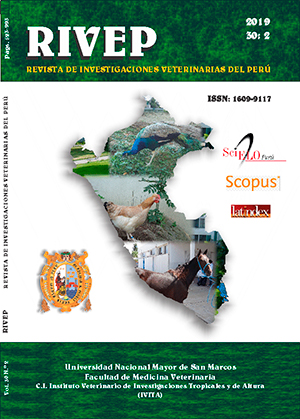Effect of dietary probiotic, prebiotic and their combination on the productive performance of guinea pigs (Cavia porcellus)
DOI:
https://doi.org/10.15381/rivep.v30i2.16071Keywords:
guinea pig; probiotic; prebiotic; symbiotic; El MantaroAbstract
The present study evaluated the effect of the inclusion of probiotic, prebiotic and the combination of both (symbiotic) in the diet on the productive parameters of guinea pigs (Cavia porcellus). Fifty 3-day-old male guinea pigs were selected from a Prolific-Dairy maternal line developed in the IVITA-El Mantaro Research Station (Peru) and randomly distributed in five treatments consisting of a basal diet of forages (rye-grass and red clover). supplemented with wheat bran (T5), plus probiotic (T1), prebiotic (T2), symbiotic (T3) and antibiotic growth-promoter (AGP) (T4). The probiotic was a mixture of six bacterial species isolated from the intestine and guinea pig faeces; the prebiotic was a commercial mannanoligosaccharide and the APC was Zn-bacitracin. The response to treatments was evaluated for 56 days in terms of body weight gain, feed intake and feed conversion ratio. No significant or consistent responses were observed as effect of the treatments. The lack of response to AGP and the good body weight gains obtained suggested that, under the conditions of the study, the intestinal microbial balance of the animals was appropriate.
Downloads
Downloads
Published
Issue
Section
License
Copyright (c) 2019 Cynthia Valdizán G., Fernando Carcelén C., Miguel Ara G., Sandra Bezada Q., Ronald Jiménez A., Ana Ascencio M., Jorge Guevara V.

This work is licensed under a Creative Commons Attribution-NonCommercial-ShareAlike 4.0 International License.
AUTHORS RETAIN THEIR RIGHTS:
a. Authors retain their trade mark rights and patent, and also on any process or procedure described in the article.
b. Authors retain their right to share, copy, distribute, perform and publicly communicate their article (eg, to place their article in an institutional repository or publish it in a book), with an acknowledgment of its initial publication in the Revista de Investigaciones Veterinarias del Perú (RIVEP).
c. Authors retain theirs right to make a subsequent publication of their work, to use the article or any part thereof (eg a compilation of his papers, lecture notes, thesis, or a book), always indicating the source of publication (the originator of the work, journal, volume, number and date).










